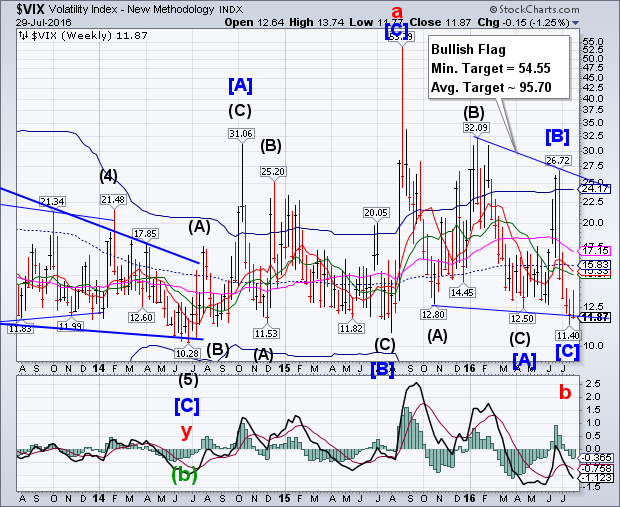
VIX rallied early in the week, but pulled back to the trendline by the close.This appears to be a valid reversal pattern.If so, payback may be coming in a very big way to those who have become complacent.
(Bloomberg) The trader love affair with (VIX) exchange-traded notes that rise as stock market turbulence increases is getting torrid again. That’s good news for equity market bulls, if history is any guide.
SPXat Cycle Top resistance a third week.

SPXhas been challenging its Orthodox Broadening Top and weekly Cycle Top resistance at 2174.36for the past three weeks. During the last two weeks its trading range has been less than 1% (2155.79 to 2177.09).Normally, a flat trading range may indicate a consolidation prior to a continuation of the trend. However, SPX has fulfilled all its requirements for a completed uptrend.In fact, the Wave [5] fractal target was 2157.71, a target that was achieved nearly three weeks ago. Could that be why the rally suddenly ran out of steam?
(ZeroHedge) While stocks surged to start the months, they end with the longest narrow (<1%) range in 45 years... (Ryan Detrick, senior market strategist at LPL Financial, noted on Twitter that Thursday marked the 11th straight day the S&P 500 closed inside a 1% trading range, the first time this has ever happened, according to records going back to 1970. So for the first time since at least the Nixon administration, stocks have been stuck inside an insanely tight window.)
NDXcould not reach its cycle Top resistance.

NDXmade a new high this week, but could not reach its weekly Cycle Top at 4776.83.However, it did reach its fractal target at 4732.24 on Friday. Thedelay in reaching its target may be why the rally had extended the past two weeks. On the other hand, the Dow Jones Industrials have not made a new high since July 20, after peaking short of its fractal target.
(ZeroHedge) Two weeks ago, an already bearish Jeff Gundlach appeared to hit the "glass floor" of negative sentiment, and smash right through it.
On July 13, the new bond king said that there is "big money" to be made on the "short side." Gundlach added that he has been selectively betting against shares in the Standard & Poor's 500 index and continues to favor emerging market bonds over high-yield "junk" debt. Gundlach was just as skeptical about bonds, warning that the yield on the 10-year Treasury note at around 1.38% to 1.39% "is a terrible trade location. It is the worst trade location in the history of the 10-year Treasury."
High Yield Bond Index makes a second weekly loss.
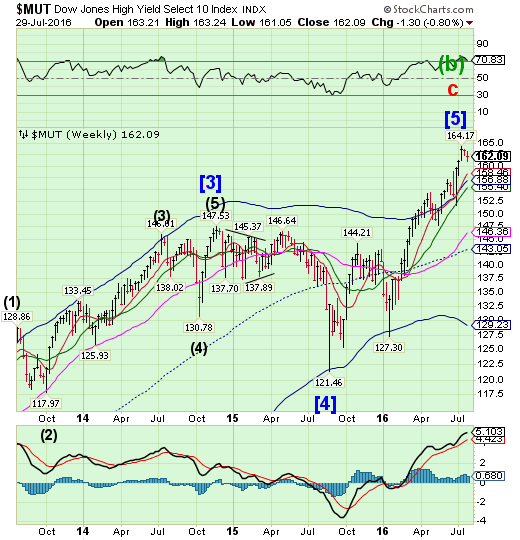
The High Yield Bond Index made two back-to-back weekly losses. Note that it reacts to similar pivots as equities, preceding the Dow high by almost a week.Investors should now be on the alert for a decline beneath its Short-term support at 158.46 for a probable sell signal
(MarketRealist) High-yield bond issuance rose last week due to better yields—compared to sub-zero yields in other developed countries.
According to data from S&P Capital IQ/LCD, dollar-denominated high-yield debt amounting to $4.1 billion was issued in the week ending July 22. In the previous week, junk bonds worth $3.9 billion were issued. The number of transactions was down slightly to seven last week from eight the previous week.
The total US dollar-denominated issuance of high-yield debt stands at $61.5 billion year-to-date in 2016. This is 32.0% lower compared to the same period in 2015.
USB retraces to Cycle Top resistance.
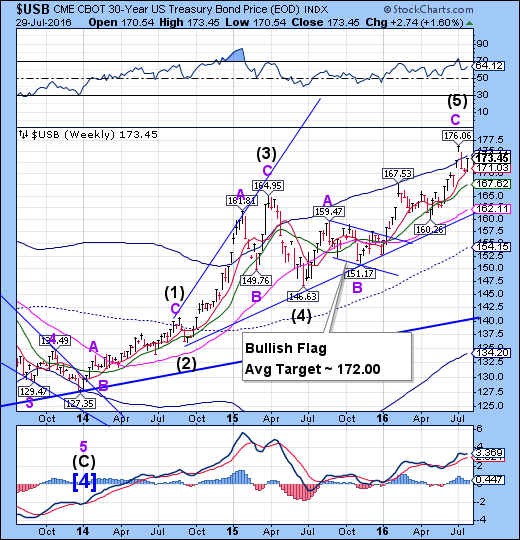
The Long Bond rallied from Short-term support to seek out its Cycle Top resistance at 174.11. Should the Cycle Top prove to be too formidable, we may see USB sell off to a lower support zone. A failure at this resistance level may also prove to be a sell signal for the Long Bond.
(WSJ) U.S. government bonds strengthened Friday after a soft report on U.S. economic growth damped expectations that the Federal Reserve would raise interest rates this fall and inspired traders to buy haven debt.
Gross domestic product grew at a seasonally adjusted annual rate of 1.2% in the second quarter, well below the 2.6% growth economists surveyed by The Wall Street Journal had forecast.
The Euroreverses to challenge resistance.

The Euroreversed from beneath the trendline of its Broadening Wedge formation to rally back toward Intermediate-term resistance at 112.21.The head & Shoulders formation may still be valid, so a second break of the trendline may put the Euro back into a possible bear market with the loss of that key support.
(Telegraph) he International Monetary Fund’s top staff misled their own board, made a series of calamitous misjudgments in Greece, became euphoric cheerleaders for the euro project, ignored warning signs of impending crisis, and collectively failed to grasp an elemental concept of currency theory.
This is the lacerating verdict of the IMF’s top watchdog on the fund’s tangled political role in the eurozone debt crisis, the most damaging episode in the history of the Bretton Woods institutions.
EuroStoxxchallenges the Flag trendline.
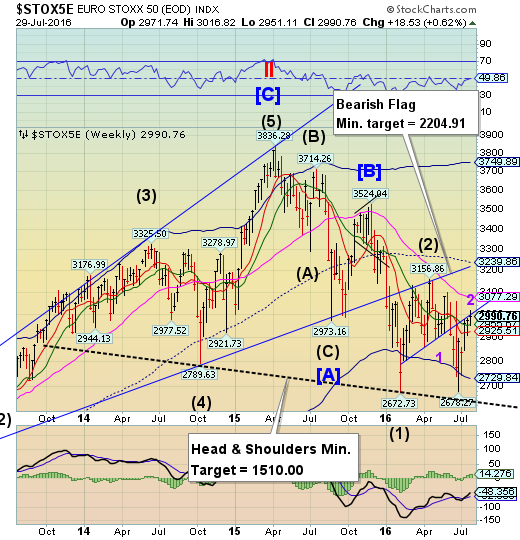
The EuroStoxx 50 Indexchallenged the trendline of a Bearish Flag formation at 2995.00, closing beneath it.The retracement pattern appears complete.A resumption of the decline beneath the neckline at 2600.00.00 maytriggeran even stronger sell-off.
(Reuters) European shares rose on Friday helped by some encouraging company updates, with Kering (PA:PRTP) gaining after its fashion brand Gucci recorded strong sales.
Financial services were in demand, with the STOXX Europe 600 Banks index topping sectoral gainers with a rise of 2.1 percent before the the release later in the day of the results of Europe-wide stress tests.
Italy's Monte deiPaschi di Siena, which is expected to be among banks that fare worst in the tests, rose 6.3 percent amid some optimim over a rescue plan that includes a 5 billion-euro capital increase.
The Yen rallies after Kuroda disappoints.

The Yensurged on Friday after the disappointing announcement by Kuroda to keep the Government Bond purchases unchanged.The Yen may have another go at its higher targets. The probable new period of strength may last through late September. A breakout above the Cycle Top appears to be probable.
(BBC) The Japanese yen has climbed by more than 2% against the US dollar, after the Bank of Japan decided to keep interest rates on hold after its two-day meeting.
The BoJ also kept its target for government bond buying unchanged.
But the central bank said it would double its annual purchase of exchange traded funds to 6tn yen ($57bn; £43bn) from the current 3.3tn yen.
Market watchers had been expecting more from the central bank.
Expectations were raised after Prime Minister Shinzo Abe announced earlier this week a 28tn yen stimulus plan to help boost the flagging economy.
See also ZeroHedge.
.The Nikkeimakes a 1000 point round trip today.

TheNikkei sold off after the BOJ announcement, then regained its losses, closing positive for the day, but unable to make up earlier weekly losses. But the damage has already been done, as the decline may have another week to go. A loss of Intermediate-term support at 16228.25 may signal a decline to the Head & Shoulders neckline.
(Reuters) Tokyo stocks rose in volatile trade on Friday as banks and insurers gained, offsetting disappointment the Bank of Japan's policy easing fell short of investors' high expectations.
Financial stocks surged as investors took heart from the central bank's decision to hold off from cutting interest rates charged on a portion of excess reserves financial institutions park at the BOJ deeper into negative territory.
The Nikkei ended 0.6 percent higher to 16,569.27, recovering from an 1.8 percent drop to 16,174.35 after the BOJ's policy decision was released.
U.S. Dollarbreaks down beneath Long-term resistance.
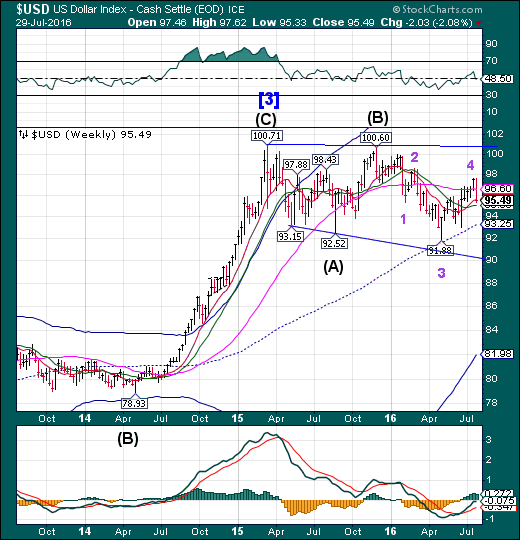
USDbroke below Long-term support/resistance at 96.60 to begin its final decline to the lower trendline near 90.00. The Cycles Model suggests thatthe decline may last three weeks or longer. As suspected, this rise above resistance was a false breakout. This Wedge formation is ultimately bullish, but unfinished in the shorter term. Once the downside target has been met, we may discuss what may follow.
(Reuters) Speculators raised bullishU.S. dollar bets this week to the highest level in nearly five
months, as investors were encouraged by strong U.S. economicdata that reinforced expectations of an interest rate hike bythe Federal Reserve in 2016.
The strong dollar position was also bolstered by short betsagainst the British pound and euro in the wake of Britain's voteto leave the European Union.
The value of the dollar's net long position increased to$13.66 billion in the week ended July 26 from $10.42 billion theprevious week, according to Reuters calculations and data from
the Commodity Futures Trading Commission released on Friday.
Goldprobes its Cycle Top resistance.
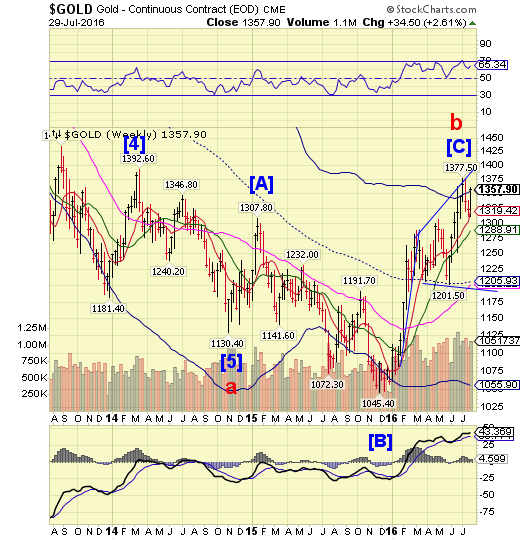
Goldrallied back to its Cycle Top resistance at 1355.96. The retracement may be over, or nearly so, as the next three weeks are due for a decline in Gold.The next support appears to be at 1250.00, but the Orthodox Broadening Top suggests a much larger decline, possibly to 1165.00.
(WSJ) Gold prices settled higher Friday, supported by disappointing U.S. economic growth data and a weak dollar.
Gold for December delivery settled up 1.2% at $1,357.50 a troy ounce on the Comex division of the New York Mercantile Exchange, its fourth consecutive day of gains.
For the second quarter, U.S. gross domestic product grew at a seasonally adjusted annual rate of 1.2%, the Commerce Department said Friday. Economists surveyed by The Wall Street Journal had forecast growth of 2.6%. The figure is the broadest measure of goods and services produced across the U.S.
Crudechallenges Long-term support.

Crude declined to challenge Long-term support at 41.14 this week. It may be due for bouncenear mid-week, but not before reaching 35.00-37.00. However, the bounce may not last more than a week before it resumes its decline into late August..
(Bloomberg) Oil climbed from a three-month low in New York as a weakening dollar bolstered investor appetite for commodities.
U.S. futures increased 1.1 percent, paring a 14 percent monthly decline. The Bloomberg Dollar Spot Index fell to the lowest since July 1 after data showing tepid U.S. economic growth dimmed prospects for higher interest rates this year. Oil declined this week as government data showed that U.S. crude and fuel stockpiles were at the highest level in decades.
Shanghai Indexencounters its last visible support.
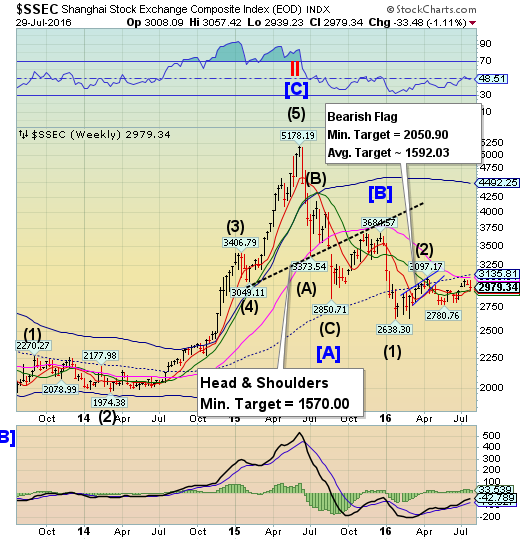
The Shanghai Indexchallenged Intermediate-term support at 2936.46 before closing the week modestly higher.It is likely that the decline may continue.The Cycles Model suggests that the Shanghai Index may decline through the end of August.
(ZeroHedge) China's burgeoning problem with its ponzi-like wealth management product or WMP, industry, is nothing new: we presented a comprehensive summary one year ago in "The 8 Trillion Black Swan: Is China's Shadow Banking System About To Collapse?"
For those unfamiliar, the outstanding value of WMPs, widely expected to be a major source of future systemic risk for Beijing, rose to 23.5 trillion yuan, or 35% of China’s gross domestic product, at the end of 2015 from 7.1 trillion yuan three years earlier. Much of the growth came in open WMPs, which are extra appealing to investors because they can be redeemed at any time, and thus provide another major duration risk which as we recently saw with commercial real estate funds in the UK, can turn sour overnight. Mid-tier banks such as China Merchants Bank Co. and China Everbright Bank Co. are especially dependent on the products for funding.
The Banking Indexrally closes at Long-term resistance.
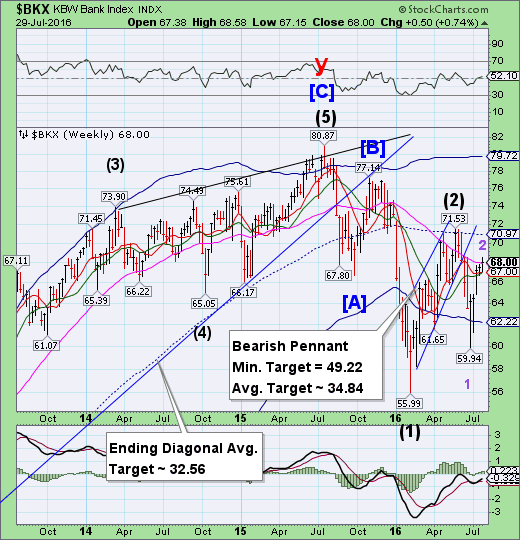
--The BKXrally off the Cycle Bottom closed Long-term resistance at 68.00 after a brief challenge above it.The Cycles Model suggests that a decline is imminent.It does not appear that the Cycle Bottom support will stop the ensuing decline.
(ZeroHedge) The latest confirmation that Germany's troubled banking giant Deutsche Bank (DE:DBKGn) is unable to navigate the troubled waters of NIRP came on Wednesday when the bank announced that its second-quarter net income fell 98% from a year earlier, hurt by weaker performances in trading, investment banking and other core areas. The lender said net income tumbled to €20 million ($22 million) from €818 million a year earlier, modestly better than the €22mm loss expected, while net revenue dropped 20% to €7.4 billion.
After rebounding modestly on the beat, the bank’s shares fell tumbled 5% on Wednesday morning, their lower level in 2 weeks; today's decline has dragged DB stock 45% lower in 2016, making it one of Europe's worst performers YTD (the Stoxx 600 is down 27% in 2016).
(ZeroHedge) Two days ago we reported that in a last ditch effort to prevent potential contagion within its banking system, one including bank runs and furious ordinary investors and depositors, ahead of Friday's stress test announcement which Italy's troubled Monte Paschi is widely expected to fail, Matteo Renzi's government was racing to organize a private bailout of the insolvent bank. Specifically, as of Monday night, the Italian government was, according to the FT, racing to secure a privately backed bailout of Monte deiPaschi di Siena, including a plan to raise €5 billion of fresh capital so as to avert nationalisation.
There was no assurance this last ditch effort would succeed, especially in light of Monte Paschi's market cap which has dropped to a paltry €800 million, suggesting that the bailout would be an effective "out of court" bankruptcy, structured as a quasi investment, with fresh money coming in from the new equity owners diluting existing stakeholders over 90%.
There was also no assurance that any new funds would not meet the same fate as the €8 billion in capital already raised over the past two years, money which has since "vaporized" in the seemingly endless hole of Monte Paschi bad debt.
(ZeroHedge) It appears causing an economic depression and significantly deteriorating life expectancy in Greece is not enough for the IMF.
In a paper published this month, the IMF seeks to study the relationship between GDP and sovereign debt restructuring using data from 1970-2010. Its main conclusion may be shocking: “the central finding of this paper is that sovereign debt restructurings with external private creditors can affect per capita GDP growth performance in the years after debt restructuring.“ And these are the people in charge of advising nations on managing their economy…
(ZeroHedge) Moments ago, the European Banking Authority published the 2016 bank stress test results, whose purpose - as every other year - is to inspire confidence in Europe's struggling banks; it differs from a market-based assessment of bank stress - that particular "test" can be seen by observing the stock prices of such giant banks as Deutsche Bank and Credit Suisse (SIX:CSGN), both of As previewed yesterday, Italy's 3rd largest, and most insolvent bank, Banca Monte di Siena was the worst performer in European regulators’ stress tests, and the only lender to have its capital wiped out in the exam. According to Bloomberg, Monte Paschi’s common equity tier 1 capital ratio, a key measure balance sheet strength, would to a negative 2.2% in an adverse economic scenario, the test revealed, which put lenders through a simulation of a severe recession over three years. Another Italian bank, UniCredit, would see its ratio fall to 7.1% , the second-worst result of the five Italian lenders being examined.
Needless, to say, the test - as structured - was a farce from the beginning as it did not account for negative interest rates, something Europe has trillions of, nor did it test for Brexit. Finally, the test did not include any banks from Greece of Portugal, where virtually all banks are currently insolvent.
Disclaimer: Nothing in this email should be construed as a personal recommendation to buy, hold or sell short any security. The Practical Investor, LLC (TPI) may provide a status report of certain indexes or their proxies using a proprietary model. At no time shall a reader be justified in inferring that personal investment advice is intended. Investing carries certain risks of losses and leveraged products and futures may be especially volatile. Information provided by TPI is expressed in good faith, but is not guaranteed. A perfect market service does not exist. Long-term success in the market demands recognition that error and uncertainty are a part of any effort to assess the probable outcome of any given investment. Please consult your financial advisor to explain all risks before making any investment decision. It is not possible to invest in any index.
